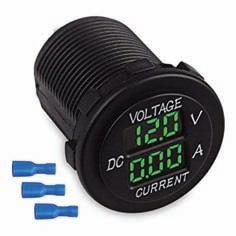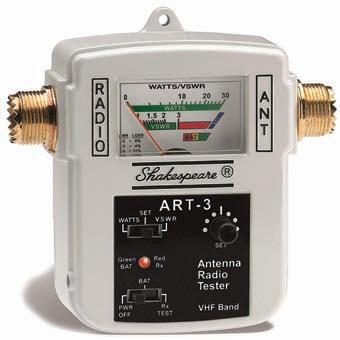
11 minute read
MAYDAY! MAYDAY
MAYDAY, MAYDAY Marine radio installations and troubleshooting
By Markus Fourie O NE of the most vital pieces of equipment on your ski-boat is the radio — your lifeline in times of trouble. In this article we will be discussing the marine radio, antenna and RF ground plane for use on ski-boats and how you can test your equipment.
Advertisement
For operating a VHF radio in a marine environment, it is highly recommended that you purchase a proper “marine radio”. Many owners look for the least expensive way out and try to modify radios for marine applications. Bad decision! Marine radios are designed and manufactured to be able to withstand saltwater and sea air conditions. Marine radios meet the requirements of frequency stability and RF radiation. Only marine radios have the facility to do DSC calling. All marine radios have the ability to switch between high power (25 watt) and low power (1 watt).
There is however one aspect where the radio manufacturers have “missed the boat”. There is no indication (or very little indication) of transmitting power or signal strength or reflected power indication on most of the marine radios. This feature would solve many
Very important: Please do not use Channel 16 for any radio testing — this is the emergency call channel.

common problems.
When installing the power and fusing circuits to the radios, make sure you use the new plastic blade fuses (shown below) that are specifically made for the auto industry. Not only are they designed for 12-volt use, but they are also sealed to protect them from harsh environmental conditions. Glass fuses start to rust and corrode and that will cause problems.
TRANSMIT MODE (TX) The radio consists of two parts — TX (transmitting) and RX (receiving). Let’s start with the transmit mode (TX) part of the radio ...
Remember to measure the distance from the radio to the battery source. The further away the radio is from the power source (batteries), the thicker your cables need to be. Often when radios have low power output it’s because the wire is too thin which is preventing proper supply of 12 volt and current to the radio.
To accurately measure the voltage do it as close as possible to the radio. Switch the radio to transmit at high power and press the “PTT”. The radio is now in transmitting mode. Now measure the voltage that the radio is getting. This test is extremely important. The voltage should not drop below 12 volt. If your radio panel goes dim when operating on high power (25 watt), it means that your supply wires are too thin.
Never transmit if there is no anten
RECEIVING MODE (RX) When it’s in receiving mode your radio is receiving all kinds of RF signals, but will only let you hear the signals that are tuned to your radio frequency.
There is a lot of noise also received by the radio, and the following can be done to determine the source of noise. Switch off all the equipment except the radio. Please remember that the antenna must be connected to the radio for this test. Turn down your squelch as far as possible. If you hear noise on the speaker, turn the squelch up till the noise just disappears, but do this adjustment very carefully, because you do not want to set the squelch level too high. The source of the noise may be on the vessel or simply nearby.
To verify the noise level start to turn on all the DC panelbreakers one by one. Some electronics have high voltage capacitors and oscillators that need to charge up, so wait till the equipment has fully started up before switching on the next breaker. This way you can determine which piece of equipment is generating noise.
Investigation of the individual items on each circuit will reveal which are the source of the noise. Major contributors of noise are battery chargers, inverters, fluorescent lamps, some makes of halogen lamps, DC pumps, autopilots and LED lights. In general LED lights are very bad for RF equipment because they tend to “kill” the small receiving signal.

ANTENNA The next important device is the antenna and how it should be connected to the radio and the ground system. The antenna should be mounted as high as possible, the closer to the radio the better.
Almost all problems associated with systems working improperly are directly related to the PL-259 coax fittings. If there is a very fine wire from the shield, not touching but near the centre conductor, when the radio transmits the 25 watts of RF energy passes through the inner of the coax, and it will arc to the outer conductor and cause an RF short.
To confirm a good connection, use a Standing Wave Ratio
SWR meter for fine tuning antennas. As this illustration shows, the height of the antenna can play a major role in the quality of your reception and transmission.


(SWR) meter or antenna tuner to test the resonant frequency of the antenna before you connect it to the radio. Check for the best reading (very low reading) — Standing Wave Ratio (SWR) reading.
The coax of the antenna must not be coiled, because this will result a high SWR reading and it will blow the RF amps of the radio, due to the magnetic field generated when you are transmitting. In receiving mode there should be no problem.
You get a lot of antennas ranging from 0 dB gain to 12 dB gain for skiboats. I think the best choice will be to use a 6 dB gain antenna, because the rocking of the boat will not influence the antenna transmission and receiving as much as with a 12 dB gain antenna.
The VHF radio produces considerable amounts of peak RF power which is routed via the 50 ohm coax to the antenna. Ideally the antenna should absorb all of the energy and convert this to radiated energy. This is also called the forward power of the radio.
RF feedback, also called reverse power, tends to occur mainly on smaller boats like jetski’s, rubberducks and fibreglass boats; they are more affected than metal-skinned boats.
RF feedback has become an increasing problem due to the more powerful VHF radios. The old 29 MHz ski-boat radio only transmits 5 watt, so all the RF feedback and antenna tuning was not as important as it is with VHF radios.
On your antenna you need to have your forward power as close to 25 watt as possible and your reverse power as close to zero as possible, then you have the ideal setup. High reverse power is also a very good indication of mis

RF GROUND PLANES A ground plane is a flat or nearly flat horizontal conducting surface that serves as part of an antenna, to reflect the radio waves from the other antenna elements. The plane does not necessarily have to be connected to ground. Ground planes are a very important part of a radio system, and also very important for instruments on the vessel like the radar system.
The ocean’s high salt content improves conductivity that can help with the ground plane. The RF resistance of the ground plane should be very low between the ground plane and the saltwater.
The ground plane should be located as deep as possible under your vessel so that when the vessel heels, the ground plane remains underwater. A good ground plane will help get the correct radiation pattern for the antenna when in transmit mode.
Creating a good ground plane on a ski-boat can be challenging, but let’s start with connecting all your stainless steel components to each other by means of a copper strip.
Getting the ground plane as close to and connected to the antenna’s earth is also important. It is also necessary to connect your radio’s chassis to this ground plane. Connecting your earth straps to the keel strip of the boat can also help. Now consider the surface area that you have created around your boat by connecting the keel strips to your ground plane.
PRE-LAUNCH CHECKS Let’s assume you have a good installation on your boat and you need to do a radio check before you go to sea. Here are some pre-check points you can do on your boat.
Transmission Test One trick to see if your radio is transmitting, is to keep an eye on the ammeter — if your boat is equipped with one. Though most boats aren’t equipped with one, this is a helpful gauge so consider having one installed. In receiving mode, your radio should read around 1 amp of current. When you transmit on high power, the ammeter should kick up to about 5 or more amps. This is a fair indication that the radio is transmitting at full power. Radio testing must be done on the 1 watt setting and not on channel 16, because this is an emergency channel.
Reception Test Confirm your radio’s “hearing ability” by tuning to a 24-hour weather broadcast station that is 25 or more kilometres away. Reception indicates that your receiver is probably okay.
Modulation Test You may be transmitting at 25 watts of power, but if your voice doesn’t “modulate” or vary the radio’s signal, no one will hear your message. A quick test is to switch to one watt, or low power, and monitor yourself on a handheld device. You may have to turn the volume down or have someone take the portable VHF down the dock to prevent “squelching” (also known as feedback) due to signal overload. If your voice is understood, the radio is modulating okay. fuse is located and keep spare fuses handy. Loose connections and corrosion can cause radio failure. Cleaning and tightening the radio’s power cable connections can often restore normal operation.
INSTALLING YOUR RADIO Here’s a run down of the very basic equipment needed to do a proper installation:
You need to have a watt meter (right) to test the forward power and the reverse power of the radio (forward power may not exceed 25 watt). You will also need a proper SWR meter to test the antenna and coax resistance on the correct frequency range that you are going to work on. A multimeter cannot do these measurements. Then you need a signal generator to generate the frequency that you are going to use to see if your radio is receiving this signal.
Mic test If the radio doesn’t transmit or you get reports from nearby boaters that they can’t hear you or that you are cutting in and out, the microphone cable may be at fault. While listening on a handheld VHF, stretch and manipulate the microphone cable to see if you can pinpoint an intermittent wire in the cable. If found, twist or fold the cable to find a position where the microphone will work and then wrap electrical tape or a zip tie around the cable to maintain that position.
Antenna and cable check If you can only make contact with nearby boats, you may have an antenna or cable problem. Keep a backup antenna stowed on board as insurance. A short sailboat antenna will do, with an appropriate length of coaxial cable. You can temporarily secure the antenna to a side rail with tape or an antenna railmount to get you operational again.
Look for any cracks, which can lead to water intrusion, appearing along the antenna’s length. Identify and correct any sharp bends or crushed sections of the coax cable, since these can reduce transmission power. The antenna connector at the back of the radio is a frequent cause of radio failure. Confirm that it is free from corrosion and without tension from a tightly stretched antenna cable.

Voltage check
Radio failure due to loss of voltage is common. Know where the in-line
HANDY RADIO CHECK METER One of my favourite pieces of test equipment is the ART-3 radio/antenna tester (shown above). It’s palm-size and can also easily be mounted and connected between a VHF radio and antenna as a kind of “stethoscope” to monitor and indicate the radio’s power output and the efficiency of the antenna and to evaluate reception. The ART-3 will give you a radio check every time you use the radio.

The radio is a vital piece of equipment on your boat and it’s crucial that it works properly both for your own safety and so that you avoid being fined. If you have any further queries feel free to contact the author at Potch Marine on (018) 297 6182. Potch Marine can also supply most of the equipment discussed in the article.
NOTE: For this article I made use of info in HF Radio Installation Procedure for Marine Applications by Dr John Gregory and John Sloop.
















